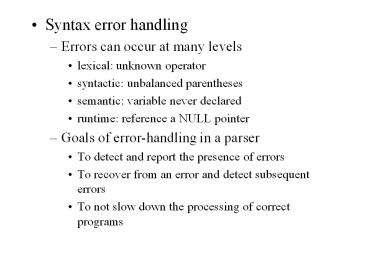Syntax error handling - PowerPoint PPT Presentation
Title:
Syntax error handling
Description:
All tokens on the same line are the same precedence level and associativity. The lines are listed in order of increasing precedence. %left PLUSnumber, MINUSnumber ... – PowerPoint PPT presentation
Number of Views:530
Avg rating:3.0/5.0
Title: Syntax error handling
1
- Syntax error handling
- Errors can occur at many levels
- lexical unknown operator
- syntactic unbalanced parentheses
- semantic variable never declared
- runtime reference a NULL pointer
- Goals of error-handling in a parser
- To detect and report the presence of errors
- To recover from an error and detect subsequent
errors - To not slow down the processing of correct
programs
2
Error recovery strategies
- Panic mode recovery
- On discovering an error, discard input symbols
one at a time until one of a designated set of
synchronizing token is found. - Phrase-level recovery
- On discovering an error, perform a local fix to
allow the parser to continue.
3
- Error recovery in predictive parsing
- Recovery in a non-recursive predictive parser is
easier than in a recursive descent parser. - Panic mode recovery
- If a terminal on stack, pop the terminal.
- If a non-terminal on stack, shift the input until
the terminal can expand. - Phrase-level recovery
- Carefully filling in the blank entries about what
to do.
4
- Error recover in LR parsing
- Canonical LR parsers never make extra reductions
when recognizing an error. - SLR and LALR may make extra reductions, but will
never shift an erroneous input symbol on the
stack. - Panic mode recovery
- Scan down stack until a state representing a
major program construct is found. Input symbols
are discarded until one is found that is in the
follow of the nonterminal. Trying to isolate the
phrase containing the error. - Phrase level recovery
- Implement an error recovery routine for each
error entry in the table.
5
- Writing a parser with YACC (Yet Another Compiler
Compiler). - Generates LALR parsers
- Work with lex. YACC calls yylex to get next
token. - YACC and lex must agree on the values for each
token. - Produce y.tab.c file by yacc yaccfile, which
contains a routine yyparse(). - yyparse() returns 0 if the program is ok,
non-zero otherwise - YACC file format
- declarations
- translation rules
- supporting C-routines
6
- The declarations part specifies tokens,
non-terminals symbols, other C constructs. - To specify token AAA BBB
- token AAA BBB
- To assign a token number to a token (needed when
using lex), a nonnegative integer followed
immediately to the first appearance of the token - token EOFnumber 0
- token SEMInumber 101
- Non-terminals do not need to be declared unless
you want to associated it with a type (will be
discussed later).
7
- Translations rules specify the grammar
productions - exp exp PLUSnumber exp
- exp MINUSnumber exp
- exp TIMESnumber exp
- exp DIVIDEnumber exp
- LPARENnumber exp RPARENnumber
- ICONSTnumber
- exp exp PLUSnumber exp
- exp exp MINUSnumber exp
8
- Yacc environment
- Yacc processes the specification file and produce
a y.tab.c file. - An integer function yyparse() is produced by
Yacc. - Calls yylex() to get tokens.
- Return non-zero when an error is found.
- Return 0 if the program is accepted.
- Need main() and and yyerror() functions.
- Example
- yyerror(str)
- char str
- printf("yyerror s at line d\n", str,
yyline) - main()
- if (!yyparse()) printf("accept\n")
- else printf("reject\n")
9
- YACC builds a LALR parser for the grammar.
- May have shift/reduce and reduce/reduce conflicts
if there are problems with the grammar. - Default conflict resolution
- shift/reduce --gt shift
- reduce/reduce --gt first production in the state
- should always avoid reduce/reduce conflicts
- yacc -v .y will generate a report in file
y.output. - See example1.y
- The programmer MUST resolve all conflicts (unless
you really know what you are doing). - modify the grammar. See example2.y
- Use precedence and associativity of operators.
10
- Use precedence and associativity of operators.
- Using keywords left, right, nonassoc in the
declarations section. - All tokens on the same line are the same
precedence level and associativity. - The lines are listed in order of increasing
precedence. - left PLUSnumber, MINUSnumber
- left TIMESnumber, DIVIDEnumber
- See example3.y
11
- Symbol attributes
- Each symbol can be associated with some
attributes. - Data structure of the attributes can be specified
in the union in the declarations. (see
example4.y). - union
- int semantic_value
- token ltsemantic_valuegt ICONSTnumber
119 - type ltsemantic_valuegt exp
- type ltsemantic_valuegt term
- type ltsemantic_valuegt item
- Semantic actions associate with productions can
be specified
12
- Semantic actions
- Semantic actions associate with productions can
be specified. - item LPARENnumber exp RPARENnumber
- 2
- ICONSTnumber
- 1
- is the attribute associated with the left
handside of the production - 1 is the attribute associated with the first
symbol in the right handside, 2 for the second
symbol, - An action can be in anyway in the production, it
is also counted as a symbol. - Checkout example5.y for examples with multiple
types associated with different symbol.

